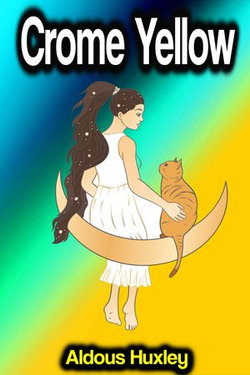Crome Yellow - Aldous Huxley - Crome Yellow is the first novel by British author Aldous Huxley, published by Chatto & Windus in 1921, followed by a U.S. edition by George H. Doran Company in 1922. Though a social satire of its time, it is still appreciated and has been adapted to different media. Crome Yellow was written during the summer of 1921 in the Tuscan seaside resort of Forte dei Marmi and published in November of that year. In view of its episodic nature, the novel was described in The Spectator as "a Cubist Peacock". This was in recognition of the fact that it was modelled on (and publicised as in the tradition of) Thomas Love Peacock's country-house novels. There diverse types of the period are exhibited interacting with each other and holding forth on their personal intellectual conceits. There is little plot development. Indeed, H. L. Mencken questioned whether its comedy of manners could be called a novel at all but hailed with delight the author's "shrewdness, ingenuity, sophistication, impudence, waggishness and contumacy." A house party at Crome is viewed largely through the eyes of Denis Stone. Described by his hostess as "one of our younger poets", he has been invited by Priscilla and Henry Wimbush to join their summer guests. Denis is secretly in love with their niece, Anne Wimbush, who appears more interested in the artist Gombauld. The rather naïve flapper, Mary Bracegirdle, decides to embark on an amorous adventure so as to overcome her repressions and makes unsuccessful advances to Denis and Gombauld before falling for the libertine Ivor Lombard one summer night. The hard-of-hearing Jenny Mullion confines most of her thoughts on what goes on to her journal, in which Denis eventually discovers a devastating deconstruction of his self and fellow guests. Mr. Wimbush, the owner of Crome, has been writing a history of the house and its family, from which he gives two evening readings. His wife is obsessed with alternative spirituality and finds a fellow sympathiser in the prolific literary hack, Mr. Barbecue-Smith. Also part of the party is Henry's former schoolfriend, the cynical Mr. Scogan, who lies in wait for anyone he can waylay with his reductive criticisms of the time and his visions for a dystopian future. After several ludicrous failures in trying to capture Anne's affection, Denis despairingly arranges to be recalled home on 'urgent family business' and departs on the same slow train that had brought him. Huxley's satire on the fads and fashions of the time is generally based on real places and people. The description of the country house at which the characters gather is recognisably based on Garsington Manor, while Ottoline Morrell has been taken for the model of Priscilla Wimbush. Scogan has been identified with Bertrand Russell, Gombauld with Mark Gertler, Mr. Calamy with H. H. Asquith, and Mary Bracegirdle with Dora Carrington. Even small comic details sometimes have a foundation in fact, as for example Mrs Bunch's massive consumption of peaches as part of the war effort. Osbert Sitwell claimed that this was based on an anecdote he had told Huxley about his own father. Some incidents in the novel allow others to grow out of them. The story of Sir Hercules Lapith, Henry Wimbush's predecessor at Crome, has imbedded within it some 64 lines in Augustan heroic couplets, far longer than all the parodies of modern verse in the book. Its function is to give an insight into its author's motives for creating his alternative society for dwarves at his home. At the same time it is a parody within a parody, since it appears as part Sir Henry's modern-day history of the house, itself a narrative within the main narrative.



Share This eBook: